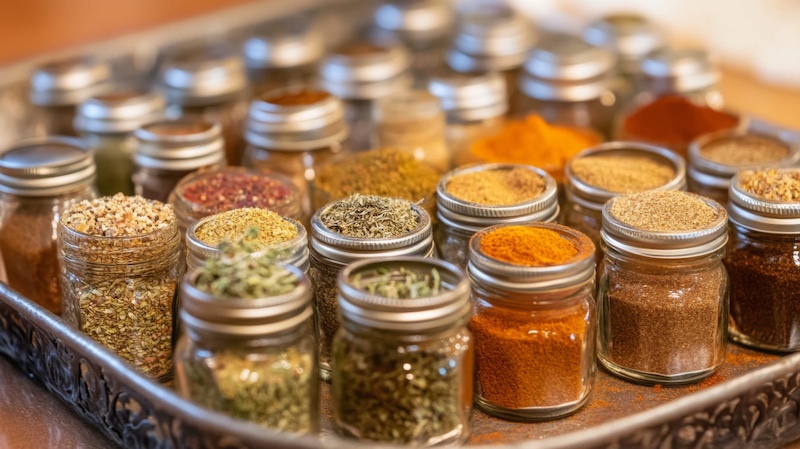Spices may seem invincible, but they have three natural enemies: light, heat, and moisture. If your spice rack is sitting right above your stove (or worse, next to the sink), it’s time for a relocation mission. Heat from cooking and moisture from boiling water can cause spices to degrade quickly. And if they’re sitting in direct sunlight? Say goodbye to their vibrant color and potency.
Pro Tip: Store your spices in a cool, dark place, like a pantry or cabinet away from any heat sources. Bonus points if it has a door to keep out light!
Ditch the Plastic, Embrace Glass or Metal
Ever noticed how the cheap plastic spice jars from the grocery store seem to get cloudy or absorb smells? That’s because plastic is porous, which means air and moisture can sneak in and start dulling your spices. The best containers? Glass jars with airtight lids or stainless steel tins. Not only do they preserve freshness, but they also look great on your kitchen shelf!
Whole Spices Are the Real MVPs
If you really want to maximize freshness, opt for whole spices instead of pre-ground ones. Grinding them yourself just before use releases their essential oils, which means bigger, bolder flavors in your cooking. Think of it like coffee—freshly ground beans taste way better than the pre-ground stuff that’s been sitting around for months!
Pro Tip: A simple spice grinder or mortar and pestle will do the trick. Your taste buds will thank you!
Label Everything (Yes, Everything)
Let’s play a game: Go to your spice rack and find the jar of dried basil. Can you remember when you bought it? If the answer is “no idea,” it’s time for some labeling action! Spices lose potency over time, so knowing when you purchased them can help you decide when it’s time to say farewell.
Pro Tip: Use a label maker or a simple piece of masking tape and a marker to jot down the date of purchase. Whole spices last about 3-4 years, ground spices about 2-3 years, and dried herbs around 1-2 years.
Keep Your Hands (and Spoons) Dry
Ever tapped a spoon into your spice jar and then noticed weird clumps forming? That’s moisture, and it’s the enemy of freshness! Water can lead to mold growth and shorten the lifespan of your spices. Always use a dry spoon when scooping spices, and resist the temptation to shake the jar directly over a steaming pot—it just invites moisture inside.
Spice Drawer vs. Spice Rack: Which Is Better?
This one is a personal preference, but if you want maximum freshness, a spice drawer wins over an open spice rack every time. Why? It keeps spices in the dark and away from temperature fluctuations. If you love the look of a spice rack, just make sure it’s in a cool, dim spot.
Don’t Store Spices in the Freezer
It might seem like a good idea to freeze spices, but the constant temperature changes when you take them in and out can cause condensation, leading to moisture buildup. Instead, just store them in an airtight container in your pantry.
Bulk Buying? Proceed with Caution
Buying spices in bulk can be great for your wallet, but only if you use them quickly! If you’re stocking up on a rarely used spice, consider splitting the batch—keep a small amount in a jar for everyday use and store the rest in a vacuum-sealed bag in a cool, dark place.
Final Thoughts: Treat Your Spices Like Gold!
Spices are the soul of great cooking, but only if they’re fresh and full of flavor. By storing them properly, you’ll get the most out of every pinch, dash, and sprinkle. So go ahead—do a little spice audit, make some storage tweaks, and let your seasonings shine!
